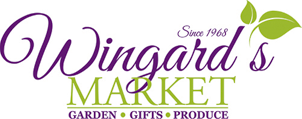
By Kathy Torres
No fewer than 63.1 million people fed birds in their backyards in 1991, according to the U.S. Fish and Wildlife Service. In addition, $2 billion was spent on bird seed alone, a figure that does not include money spent on bird feeders and other equipment (reported by The Washington Post – Click HERE for the article.) I believe it’s a safe bet that the numbers have only increased in the last decade and that birding is alive and flourishing in the United States standing firmly in the outdoor recreation economy.
Turning our homes into our playgrounds became very popular recently, during the Covid-19 pandemic. Not only did we spend more time at home, but we also spent more money on our landscapes, gardens, etc. to enhance our experience while stuck at home. The appeal of a bird feeder or two, combined with a bird bath, also inspired us, as our interest in the beautiful wildlife right around us expanded. Of course, as the numbers above illustrate, there was a hefty population already on the birding bandwagon. It’s certainly not new, and a hobby enjoyed by many, but the interest has risen to new heights. Humans seem to be realizing the pleasure and reward found in observing and caring for birds, our charming neighbors of many colors, sounds, and characteristics!
The Post also reported “when just two bird fanciers get together, they can talk at length about the relative merits of different kinds of bird seed and the myriad ways to foil squirrels bent on snatching seed. Further, bird fanciers proudly list the kinds of birds that visit their backyard feeders as if they were counting precious pearls.” The variety of birding merchandise available to the consumer in local garden centers has opened up a whole new world of choices for bird enthusiasts. Because it has become so popular, new creativity in products available has emerged on store shelves over recent years, providing an upgrade in feeders and seed, and the conclusion is that the benefits of spending a little more are definitely worthwhile.
Many of us have learned the hard way, that good seed is a must in our feeders. The first feeder that I added to my yard was quite inexpensive and so was the seed I purchased. I had no clue what was in it or what varieties of birds it would attract. What I realized quickly, was that a lot of the seed was being discarded, creating a lovely patch of weeds under the feeder. The last thing you want is for the seed to create a mess. The primary reasons this happens are… (1) Seeds may have inedible hard outer shells. Birds crack open the shell to get to the meaty kernel inside while the outer hulls drop to the ground below, and (2) Not all birds like all seeds or foods. Birds will eat their favorite first and throw the rest out of the feeder and onto the ground. Buying a better seed or seed mix gives you more bang for your buck and cuts down on creating additional work for yourself cleaning up the ground around the feeder.
So, what is better birdseed? If you want to keep it simple but attract a variety of birds, black oil sunflower seed reigns supreme in the backyard bird-feeding world and is a great way to get started. (There will be some cleanup of the discarded shells, so, if you would rather not go there, consider the shelled version.) “Black oil sunflower seeds are related to regular sunflower seeds, but they’ve been cultivated to have a higher fat content,” says John Rowden, the senior director of bird-friendly communities at the National Audubon Society. For more information on black oil sunflower seed, including what birds it attracts, check out the Birds and Blooms website HERE.
When selecting quality seeds, you’ll find combinations that attract a variety of birds, as well as seeds created to attract specific birds, for instance, thistle, for finches. If you’re a beginner, it’s wise to choose the “one size fits all” version, then as you gain experience, you may wish to add a feeder with a more selective following. Most important in selecting good bird seed is making sure it doesn’t contain a lot of stuff the birds DON’T eat. Many of the less expensive seed combinations have large portions of milo, a cheap grain harvested from the sorghum plant. It is used as “filler” and most backyard birds don’t like it. Here’s an easy GUIDE from Cornell University Ornithology Labs to give you some direction on seed types to look for and the birds they attract.
The easy path to good seed will take you to Wings-n-Things, Wingard’s Birding Department, located in the Produce Market, where you will find Cole’s Wild Bird Seed brand. Like Wingard’s, Cole’s is a family business with an interesting history. To read all about it, click HERE. Their philosophy is “Birds can be very picky eaters and if you put out the wrong feed, they’ll snub their noses at you and move on to your neighbor’s feeder looking for something better.” Cole’s offers quality seeds that will bring you success at the feeder with ingredients, thoughtfully produced to meet the wants and needs of many different species of birds. The seed contains no added synthetics, no added chemicals, and no artificial flavors. And most importantly, the birds love it, so you won’t be wasting your money!
Cole’s Wild Bird Seed has a great website to access all the information you need on their products, coleswildbird.com. Check it out and if you have any questions, call Zach Steinhauser, Wingard’s wildlife conservationist, and he will get you headed in the right direction. In the meantime, here are a few of the Cole’s seed products at Wingard’s, just to get you familiar.
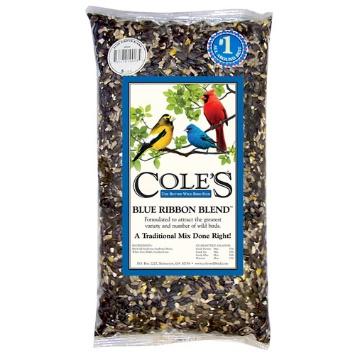
BLUE RIBBON BLEND: Contains sunflower, white millet and cracked corn. Guaranteed to bring the best combination of perch and ground feeding birds.
Attracts: Cardinals, titmice, chickadees, Goldfinches, juncos, White-throated sparrows, Indigo Bunting, wrens, grosbeaks, woodpeckers, towhees
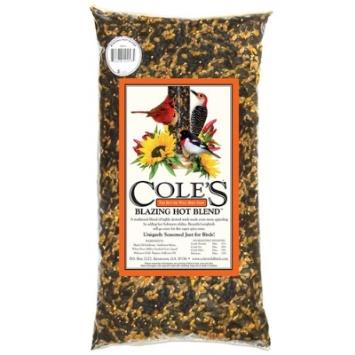
BLAZING HOT BLEND: traditional mix with most preferred seeds of backyard songbirds, combined with a habanero chili oil formula to discourage squirrels. Harmless to birds.
Attracts: Woodpeckers, grosbeaks, buntings, cardinals, chickadees, bluebirds, goldfinches, song sparrows, titmice, wrens
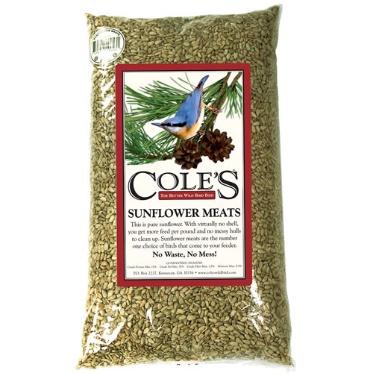
SUNFLOWER MEATS: No waste, no mess, pure sunflower. You will get more feed per pound and no messy hulls to clean up. Perfect for decks and balconies.
Attracts: Bluebirds, chickadees, cardinals, titmice, finches, woodpeckers, wrens, buntings, grosbeaks, towhees, nuthatches, song sparrows, and doves
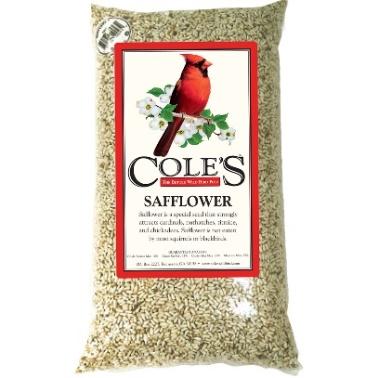
SAFFLOWER: Favorite of Cardinals. Squirrels and large “nuisance” birds don’t like it!
Attracts: Cardinals, nuthatches, titmice, and chickadees
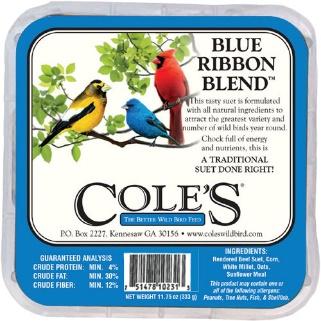
SUET BLUE RIBBON BLEND: Bluebirds, cardinals, chickadees, warblers, buntings, nuthatches, woodpeckers, wrens
Attracts: Cardinals, nuthatches, titmice, and chickadees
Cole’s DOES NOT use filler seeds like Milo, Wheat, Red Millet, Flax, or old crop leftovers. Only the top 1-2% of each crop is used and cleaned a minimum of 4 times to ensure you get good quality seed – not sticks and dirt. Seeds are kept as close to a natural state as possible and never washed with chemicals or oil to make them look better.
As winter approaches, it’s time to think about helping the birds get through. By providing food, we can increase their capability to survive and flourish. And while giving this aid, we are paid back in full, and then some, by the beauty of wildlife right in our own backyards. If you really get the birdwatching fever, you can participate in Cornell’s FeederWatch tracking program. The season begins November 1. FeederWatch – Count Feeder Birds for Science.
Just to entice you, take a look and listen HERE.
